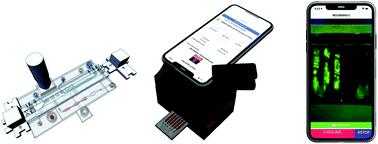Our official English website, www.x-mol.net, welcomes your feedback! (Note: you will need to create a separate account there.)
Smartphone clip-on instrument and microfluidic processor for rapid sample-to-answer detection of Zika virus in whole blood using spatial RT-LAMP
Analyst ( IF 4.2 ) Pub Date : 2022-06-15 , DOI: 10.1039/d2an00438k Aaron M Jankelow 1, 2 , Hankeun Lee 2, 3 , Weijing Wang 2, 3 , Trung-Hieu Hoang 3 , Amanda Bacon 2, 3 , Fu Sun 2, 3 , Seol Chae 2, 3 , Victoria Kindratenko 1, 2 , Katherine Koprowski 1, 2 , Robert A Stavins 4 , Dylann D Ceriani 5 , Zachary W Engelder 5 , William P King 2, 4 , Minh N Do 3 , Rashid Bashir 1, 2, 3, 4, 6 , Enrique Valera 1, 2 , Brian T Cunningham 1, 2, 3, 6
Analyst ( IF 4.2 ) Pub Date : 2022-06-15 , DOI: 10.1039/d2an00438k Aaron M Jankelow 1, 2 , Hankeun Lee 2, 3 , Weijing Wang 2, 3 , Trung-Hieu Hoang 3 , Amanda Bacon 2, 3 , Fu Sun 2, 3 , Seol Chae 2, 3 , Victoria Kindratenko 1, 2 , Katherine Koprowski 1, 2 , Robert A Stavins 4 , Dylann D Ceriani 5 , Zachary W Engelder 5 , William P King 2, 4 , Minh N Do 3 , Rashid Bashir 1, 2, 3, 4, 6 , Enrique Valera 1, 2 , Brian T Cunningham 1, 2, 3, 6
Affiliation

|
Rapid, simple, inexpensive, accurate, and sensitive point-of-care (POC) detection of viral pathogens in bodily fluids is a vital component of controlling the spread of infectious diseases. The predominant laboratory-based methods for sample processing and nucleic acid detection face limitations that prevent them from gaining wide adoption for POC applications in low-resource settings and self-testing scenarios. Here, we report the design and characterization of an integrated system for rapid sample-to-answer detection of a viral pathogen in a droplet of whole blood comprised of a 2-stage microfluidic cartridge for sample processing and nucleic acid amplification, and a clip-on detection instrument that interfaces with the image sensor of a smartphone. The cartridge is designed to release viral RNA from Zika virus in whole blood using chemical lysis, followed by mixing with the assay buffer for performing reverse-transcriptase loop-mediated isothermal amplification (RT-LAMP) reactions in six parallel microfluidic compartments. The battery-powered handheld detection instrument uniformly heats the compartments from below, and an array of LEDs illuminates from above, while the generation of fluorescent reporters in the compartments is kinetically monitored by collecting a series of smartphone images. We characterize the assay time and detection limits for detecting Zika RNA and gamma ray-deactivated Zika virus spiked into buffer and whole blood and compare the performance of the same assay when conducted in conventional PCR tubes. Our approach for kinetic monitoring of the fluorescence-generating process in the microfluidic compartments enables spatial analysis of early fluorescent “bloom” events for positive samples, in an approach called “Spatial LAMP” (S-LAMP). We show that S-LAMP image analysis reduces the time required to designate an assay as a positive test, compared to conventional analysis of the average fluorescent intensity of the entire compartment. S-LAMP enables the RT-LAMP process to be as short as 22 minutes, resulting in a total sample-to-answer time in the range of 17–32 minutes to distinguish positive from negative samples, while demonstrating a viral RNA detection as low as 2.70 × 102 copies per μl, and a gamma-irradiated virus of 103 virus particles in a single 12.5 μl droplet blood sample.
中文翻译:

智能手机夹式仪器和微流体处理器,使用空间 RT-LAMP 快速检测全血中的寨卡病毒
对体液中病毒病原体进行快速、简单、廉价、准确且灵敏的即时护理 (POC) 检测是控制传染病传播的重要组成部分。主要的基于实验室的样本处理和核酸检测方法面临着局限性,导致它们无法在资源匮乏的环境和自检场景中广泛采用 POC 应用。在这里,我们报告了一个集成系统的设计和表征,该系统用于快速从样本到答案检测全血液滴中的病毒病原体,该系统由用于样本处理和核酸扩增的两级微流体盒和夹子组成。与智能手机图像传感器接口的检测仪器。该试剂盒旨在通过化学裂解从全血中释放寨卡病毒的病毒RNA,然后与测定缓冲液混合,在六个平行的微流体隔室中进行逆转录酶环介导的等温扩增(RT-LAMP)反应。电池供电的手持式检测仪器从下方均匀加热隔间,一系列 LED 从上方发光,同时通过收集一系列智能手机图像来动态监控隔间中荧光报告器的生成。我们描述了检测掺入缓冲液和全血中的寨卡 RNA 和伽马射线灭活寨卡病毒的测定时间和检测限,并比较了在传统 PCR 管中进行的相同测定的性能。我们对微流体室中荧光产生过程进行动力学监测的方法能够以一种称为“空间灯”(S-LAMP)的方法对阳性样品的早期荧光“绽放”事件进行空间分析。我们表明,与整个隔室平均荧光强度的传统分析相比,S-LAMP 图像分析减少了将检测指定为阳性检测所需的时间。S-LAMP 使 RT-LAMP 过程缩短至 22 分钟,从而使从样本到应答的总时间在 17-32 分钟范围内,以区分阳性样本和阴性样本,同时证明病毒 RNA 检测率低每μl 2.70 × 10 2 个拷贝,以及单个12.5 μl 液滴血样中含有10 3 个病毒颗粒的伽马射线照射病毒。
更新日期:2022-06-15
中文翻译:

智能手机夹式仪器和微流体处理器,使用空间 RT-LAMP 快速检测全血中的寨卡病毒
对体液中病毒病原体进行快速、简单、廉价、准确且灵敏的即时护理 (POC) 检测是控制传染病传播的重要组成部分。主要的基于实验室的样本处理和核酸检测方法面临着局限性,导致它们无法在资源匮乏的环境和自检场景中广泛采用 POC 应用。在这里,我们报告了一个集成系统的设计和表征,该系统用于快速从样本到答案检测全血液滴中的病毒病原体,该系统由用于样本处理和核酸扩增的两级微流体盒和夹子组成。与智能手机图像传感器接口的检测仪器。该试剂盒旨在通过化学裂解从全血中释放寨卡病毒的病毒RNA,然后与测定缓冲液混合,在六个平行的微流体隔室中进行逆转录酶环介导的等温扩增(RT-LAMP)反应。电池供电的手持式检测仪器从下方均匀加热隔间,一系列 LED 从上方发光,同时通过收集一系列智能手机图像来动态监控隔间中荧光报告器的生成。我们描述了检测掺入缓冲液和全血中的寨卡 RNA 和伽马射线灭活寨卡病毒的测定时间和检测限,并比较了在传统 PCR 管中进行的相同测定的性能。我们对微流体室中荧光产生过程进行动力学监测的方法能够以一种称为“空间灯”(S-LAMP)的方法对阳性样品的早期荧光“绽放”事件进行空间分析。我们表明,与整个隔室平均荧光强度的传统分析相比,S-LAMP 图像分析减少了将检测指定为阳性检测所需的时间。S-LAMP 使 RT-LAMP 过程缩短至 22 分钟,从而使从样本到应答的总时间在 17-32 分钟范围内,以区分阳性样本和阴性样本,同时证明病毒 RNA 检测率低每μl 2.70 × 10 2 个拷贝,以及单个12.5 μl 液滴血样中含有10 3 个病毒颗粒的伽马射线照射病毒。


























 京公网安备 11010802027423号
京公网安备 11010802027423号